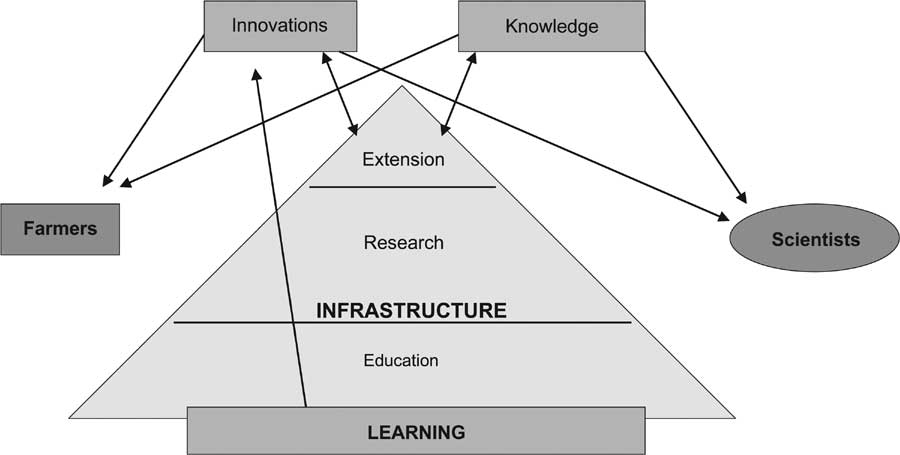kind of training centers that are linked simultaneously to higher education and retraining of specialists is extremely important for strengthening and developing farmersâ movements. AKST systems of different countries have their own development priorities and programs. Collaborative scientific programs may stipulate that the national system must act jointly on a specific crop or aspect of scientific research. Such program requirements will affect the agricultural education system and the entire process of developing innovations. Methods should be developed and shared among CWANA countries, possibly in well-known universities and research centers in the region.
Integrating education, research and extension is a principal task for CWANA to accomplish to achieve its sustainable development goals (Figure 5-2).
Options for strengthening the integration of AKST stakeholders include:
Option 1: Involvement of AKST stakeholders. The gap
analysis has identified the insufficient involvement of many
AKST stakeholders (Belaid et al., 2003). Considering the
mandates of these institutions and the important contribution
they could make to improving agricultural production
and developing capacity of the region, their involvement in
the region should be significantly enhanced (Box 5-1).
Option 2: Regional cooperation. To reorient regional cooperation
and facilitate implementation of the identified regional
AKST institutions, some key approaches were identified,
such as networks, coordination meetings and traveling
workshops. Existing networks, such as among universities
and research institutes, need to be reviewed and consolidated.
International centers in CWANA like ICARDA may
facilitate such reviews and consolidation. Joint projects (interuniversity,
between research centers) can enhance regional
collaboration and cooperation, through various types of
projects that include education, research and extension. The
key innovation of the CWANA regional priority-setting exercise
was to set the right conditions for a dialogue where
ânontraditional stakeholdersâ, i.e., farmers, NGOs, the private
sector and grassroots organizations, would play a central
role. CWANA countries have the opportunity to use cooperational
links independently, create a special regional association
of agricultural education, research and extension
institutions, and interconnect them with a unified network.
In view of the complexity of challenges facing the region it is
unlikely that AKST regional institutions will be able to satisfactorily
address them on their own. This in turn highlights
the urgency of establishing strategic partnerships to tackle
the problems of developing agricultural capacity in the region.
The strategic partnership should seek to link the education,
research and extension initiatives to the development
goals of alleviating poverty and improving food security.
Option 3: Applying a participatory approach. Participatory
bottom-up approaches can be done at three levels: (1)
regional, (2) CWANA subregional, and (3) North Africa,
West Asia, Central Asia and Caucasus. The valuable lessons
learned from previous case studies (Belaid et al., 2003;
Thomas et al., 2003) have triggered the need to develop
mechanisms that will expand collaboration and dialogue
through sustainable links and strategic partnerships with
ânontraditionalâ stakeholders, especially NGOs, farmers,
grassroots organizations and the private sectorâthe ultimate
clients of agricultural innovation system products and
innovations. In national agricultural information systems,
the collaborative relationships with universities, NGOs, the
private sector, farmers, and farmersâ organizations are, by
and large, at an embryonic stage and need therefore to be
significantly consolidated (Belaid et al., 2003).
5.2.3.3 Agricultural knowledge management using information and communication technology
The central purpose of knowledge management is to transform information and intellectual assets into enduring value

Figure 5-2. Integration of education, research and extension. Source: Authorsâ elaboration.